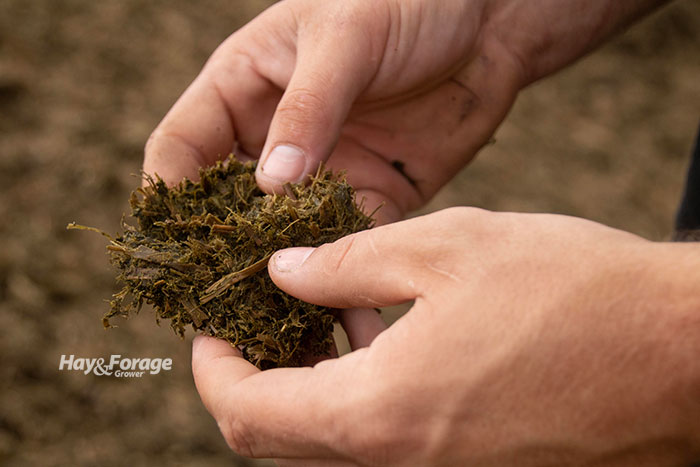Forage fragility affects rumen function |
| By Amber Friedrichsen, Associate Editor |
|
|
 Energy level and crude protein content tend to be the primary forage quality characteristics producers refer to when feeding livestock; however, forage fragility is another key factor to consider when formulating dairy cattle rations. Kassidy Buse, dairy nutrition research coordinator with the University of Nebraska, says forage fragility is the rate at which forage particle size is reduced through chewing, sometimes referred to as the scratch factor. In general, grasses have lower forage fragility while legumes have a higher forage fragility, although plant maturity also comes into play. “To visualize this, imagine you are holding grass hay in one hand and alfalfa hay in the other,” Buse says. “When you squeeze the grass hay, it is pliable and easily compactable, thus having lower fragility. But, when you squeeze the alfalfa hay, it is stiff and probably breaks, giving it a higher forage fragility.” Forage fragility is correlated to the amount of cellulose, hemicellulose, and lignin in plants. For this reason, the ratio of acid detergent fiber (ADF) and neutral detergent fiber (NDF) can be used as an indirect measure of forage fragility. “The NDF fraction of fiber contains cellulose, hemicellulose, and lignin, while the ADF fraction doesn’t account for hemicellulose,” Buse explains. “Because of the stabilizing nature of hemicellulose, forages that have a high ADF-to-NDF ratio will have a lower fragility, while a lower ADF-to-NDF ratio will indicate a high fragility.” Grasses have more hemicellulose than legumes. The cross-links between this hemicellulose and other structural components — primarily lignin — make grasses less fragile. Grasses contribute more physically effective NDF (peNDF), which is the portion of fiber that stimulates rumination, or chewing activity. “When chewing is increased, cows produce more saliva, which in turn helps with buffering and maintaining the rumen environment,” Buse states. Forages that are more fragile, on the other hand, require less chewing to achieve smaller particle sizes. These plants contribute less peNDF and have higher passage rates. This speeds up digestibility and ultimately affects the rumen mat, gut fill, and dry matter intake. 
Adjust rations accordingly In addition to the ratio of ADF-to-NDF, there are other methods to measure forage fragility. For example, the Penn State Particle Separator can be used under the assumption that less fragile forage will retain more particles on the 1.18-mm screen. Ball milling is another type of forage fragility analysis that involves tumbling a sample of dried forage in a mill with ceramic balls that mimic the physical breakdown of chewing. The difference of the forage sample’s peNDF before and after milling is then calculated to estimate forage fragility. Buse notes few commercial forage laboratories offer ball milling analysis, and there is ultimately a need for more effective techniques to measure forage fragility. With that said, knowing the basic principles of forage fragility can help guide dairy ration development. “Diets containing forages with a lower fragility, such as grasses or any late-maturity hay, present the opportunity to include more concentrates, nonforage fiber sources, or other rapidly digested feedstuffs due to the increased buffering capacity,” Buse suggests. “When higher quality, more fragile forages are used, and additional ingredients will need to be brought into the ration to help maintain the rumen environment and slow the passage rate.”  Amber Friedrichsen Amber Friedrichsen served as the 2021 and 2022 Hay & Forage Grower summer editorial intern. She currently attends Iowa State University where she is majoring in agricultural communications and agronomy.
|
